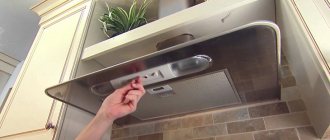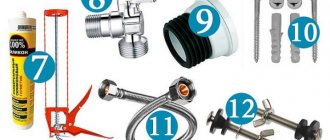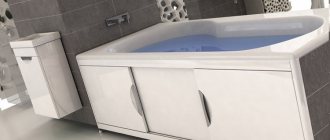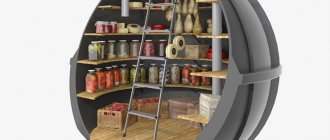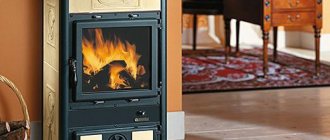After purchasing and installing interior doors, the question of installing fittings arises. This problem can be solved by calling a specialist or studying the technology of cutting in a locking device and performing the procedure on their own.
Experts recommend purchasing and installing interior doors with a built-in lock. In this case, there is no need to install it. But they cost much more. In order to minimize financial resources, some craftsmen try to attach locks themselves.
These instructions will help you install a lock on an interior door. Beginners who have not yet encountered such a process will be able to understand all the nuances and perform the procedure for installing the mechanism with their own hands.
Tools and materials
To mortise the lock, we need to prepare the following tool:
- tape measure, pencil and carpenter's square;
- screwdrivers or screwdriver with a set of bits;
- electric drill, wood drills (6 mm and feather) + suitable crowns in two sizes;
- chisel and hammer;
- chisel or hand router.
Please note : there are special kits for inserting locks on sale, which include drills and crowns of suitable sizes.
Preparatory stage
The installation technology depends on the configuration of the selected lock. The easiest way is to embed a handle - a latch, under the compact mechanism of which it is easy to drill a hole of a suitable diameter. Inserting a lock with a handle and a cylinder (or a rotary lock) is a more complex process, since you will have to work on the socket at the end of the door and make two holes in the door leaf - for the handle and the cylinder.
Before embedding a lock into a new door without fittings, it is important to correctly determine the installation height of the handle. If the door is made of wood, there are no technical restrictions; you can choose any convenient height. A frame door is more capricious: in order not to damage the structure, the handle should be mounted at the location of the cross beam, which is usually located at a height of 90 - 100 cm from the bottom edge of the door leaf.
As a rule, the lock is cut into an already hung door leaf, but this can be done in advance, before installing the door system. If the lock socket is to be cut using a hand-held electric router, the door leaf should be securely fixed in a horizontal position with the processed end facing up.
Requirements for locking devices
First of all, locking devices are subject to requirements regarding their functionality:
- The gate latch must be made in a single body with precisely fitted moving mechanisms.
- The device should not rattle during operation.
Important! The latch on the gate must be lubricated periodically, but for a high-quality device, applying lubricant twice a year is enough.
You can use liquid lubricant, for example, industrial oil or solid lubricant - litol, grease, etc. Litol is the most practical and resistant to external influences.
- The design of the housing and mechanisms must allow quick disassembly, cleaning and subsequent reassembly.
- Structural elements must allow the owner to replace them independently.
- There must be fasteners available, and the body must have special grooves or lugs for installation.
There are also criteria that determine safety:
- The lock when opening/closing should not damage the hands of the person closing it.
- The structure must be securely mounted in the appropriate place of the gate or other fence.
Handle insert - latches
First, let's look at how to install the handle-latch. First of all, marking should be done. Having decided on the height of the handle, place the lock mechanism on the door leaf flush with the edge, circle it, mark with a pencil the place where the eyelet is located - this is where you will need to drill a hole for the handle pin.
Using a carpenter's square, the horizontal lines of the lock's outline on the door must be transferred to the end of the door. Using a tape measure, find the middle of the horizontal lines at the end and draw a vertical line with a pencil. The middle of this axis is the center of the future hole for the lock mechanism. You can do it easier and use the door mechanism itself to mark the location of the handles.
Having completed the markings, drill a hole in the door leaf for the handle using a crown mounted on a drill with a diameter of 6 mm.
Important! To avoid chipping and other damage to the decorative layer, drilling is performed with a crown on both sides. When the end of the pilot drill goes through the door and the crown is about halfway through the door, start drilling on the other side of the door, inserting the drill into the hole. The size of the crown is selected in such a way that nothing interferes with the lock mechanism’s normal functioning, while the hole must be completely covered with decorative overlays of the handle-latch.
At the end of the door, a hole for the latch is drilled with a feather drill of a suitable size or a small crown. If necessary, the recess can be expanded with a chisel.
Then insert the latch mechanism into the hole in the end and trace the outline of the strip. It must be installed flush with the surface, so you will have to make a recess under it using a chisel. For a veneered door, the veneer layer is first removed in the marked place.
Next, the handle-latch is installed. The mechanism is inserted into the hole and secured to the end with standard fasteners using a screwdriver or screwdriver. The handle should be disassembled according to the diagram provided by the manufacturer.
Pay attention to the location of the latch tongue and the handle on which the door closing button is provided. After installing the decorative trims, pass the pin through the hole in the latch mechanism and secure the handles by tightening them with screws (in some cases, additional holes must be drilled for the tightening screws). Make sure the lock-latch is functioning properly.
At the final stage, a strike plate is installed on the door frame to secure the latch tongue. Carefully closing the door with the latch exposed, mark the location for the hole. Using a chisel, make a recess, attach and trace the contour of the striker - you will also need to make a cut under it in order to install it flush. Secure the bar with standard self-tapping screws.
Insertion of the mechanism with the “larva”
Installation of a door lock with a “cylinder” is carried out according to the same scheme. After marking the end, using a suitable sized drill bit, you should make a vertical row of holes with a minimum spacing from each other.
Using a chisel, remove the jumpers and prepare a neat nest of the required size. In the door leaf (drill with a crown on both sides), make holes for the handle and cylinder (or rotary key) of the lock. Next, using a chisel, a sample is made for the lock bar, the mechanism and handles are installed, and the back bar is mounted.
If you have the skill to work with a hand router, you can make nests and cuts for planks with this tool, obtaining perfectly even recesses. It is necessary to work with a chisel and chisel extremely carefully, especially when cutting out curves, so that the door with a lock looks aesthetically pleasing.
Video on the topic “Inserting a lock into an interior door with your own hands”:
Choosing a lock for an interior door
Based on function and design, there are several types of door locks:
- regular latch or halyard lock;
- latch with lock;
- mortise;
- magnetic;
- overhead;
- latch;
- latch;
- level
Regular latch. This is the most primitive type of lock, which is used in almost all interior doors. It is a simple design consisting of a cylinder and a plastic or metal tongue. Often such a mechanism is mounted together with a handle that controls the tongue.
The latch is the simplest mechanism installed on interior doors
The purpose of a halyard lock is to keep the door closed. A conventional latch is simple, reliable in operation, and characterized by a wide range of designs . However, due to the overly simple mechanism, it has not found widespread use.
Latch with lock. It is considered a variation of a regular latch, which is equipped with an additional latch. It blocks the movement of the handle. There are two types: lever and push-button. The first type is more practical and reliable. A push-button lock is no worse, but it can cause such an unpleasant situation as accidentally slamming the door.
The latch with a lock has a number of advantages: simple installation, simple design, wide selection of models. The disadvantage of this type of lock is its weak locking mechanism.
When purchasing a product, pay attention to whether the movements of the tongue are smooth and whether the spring returns it inside the door.
Mortise lock. It was popularly called a mechanism with a key cylinder. Outwardly, it is similar to a lock for street doors, but has a simpler design. The device includes a cylinder and a lock block.
Mortise locks are reliable and durable
There are two types of cylinder: “key-key” and “key-turner”. The first is installed if the lock is used occasionally. The second, on the contrary, is suitable for more frequent use.
Mortise locks are used to close bedrooms, offices, and storage rooms. They reliably protect against penetration, are durable, and rarely break . If we talk about the disadvantages of the device, then this includes the complexity of installation and the dependence of the device parameters on the thickness of the door.
Magnetic lock. If you can afford to splurge, then this type of lock is for you. It is intended primarily for rooms where it should be as quiet as possible: bedrooms, children's rooms, offices.
The magnetic lock is quiet, but its cost is quite high
Silent operation is ensured due to its design, consisting of a crossbar, a strike plate, a magnet, and a case for the magnet. The bolt is attracted to a strike plate with a magnet, which is located on the box.
(function(w, d, n, s, t) { w[n] = w[n] || []; w[n].push(function() { Ya.Context.AdvManager.render({ blockId: "RA-510923-1", renderTo: "yandex_rtb_R-A-510923-1", async: true }); }); t = d.getElementsByTagName("script")[0]; s = d.createElement(" script"); s.type = "text/javascript"; s.src = "//an.yandex.ru/system/context.js"; s.async = true; t.parentNode.insertBefore(s, t) ; })(this, this.document, "yandexContextAsyncCallbacks");
Along with the advantages of the product, there are disadvantages. Firstly, this is the impressive cost of the castle. Secondly, the lock case is not very compact in size, which is why it looks bulky.
Padlock. Products of this type can rightfully be called a rarity. However, despite this, the demand for it has not fallen to this day due to the simplicity of the mechanism and uncomplicated installation.
Current models boast a comfortable body. The device is mounted on the inside or outside of the door, thereby providing protection against unexpected entry.
Espagnolette. The original purpose of the lock was to secure one of the double doors. Currently, it is installed mainly in the bathroom and toilet.
Espagnolette installed in bathrooms
The operating principle of this product is so simple that even a small child can handle it. Its installation does not require special knowledge and experience.
Latch. This is the simplest type of castle. A latch is a metal plate with a retractable lever. It is installed as a main or auxiliary lock.
Level castle. The mechanism has become widespread due to its high degree of reliability and protection. It is used for both street and interior doors.
To fix the bolt in the mechanism, plates (levers) with grooves of various shapes are used.
Level lock has a high degree of security
Each insert has a corresponding key bit profile. The lock will open only when the levers are in the correct position and the groove is free for the bolt to pass through. .
If you have made your choice in favor of a stylish but simple lock, you can get to work.


